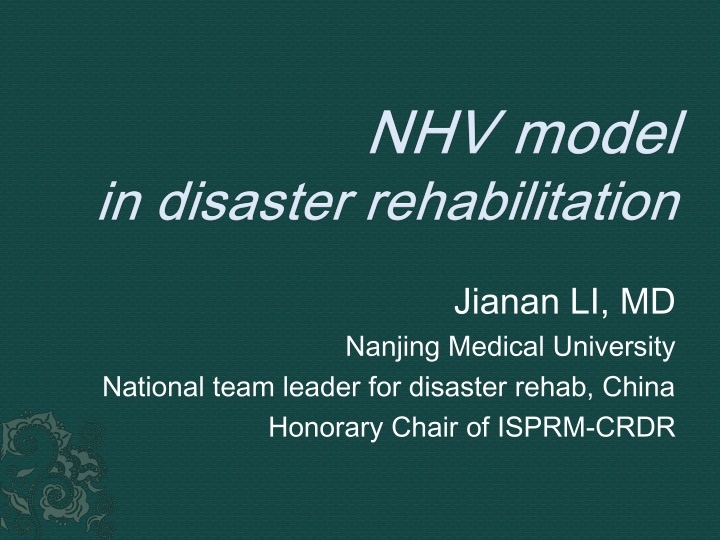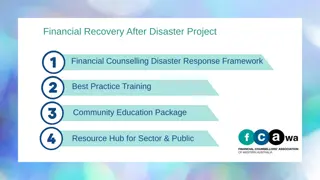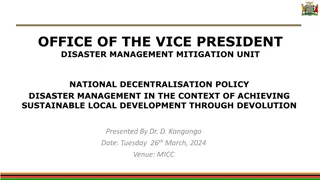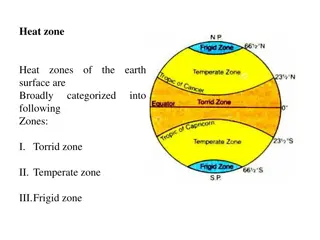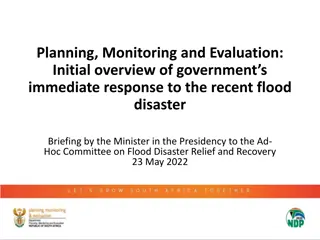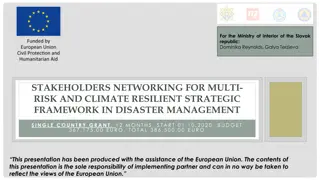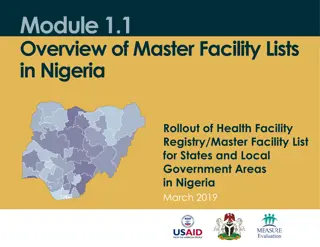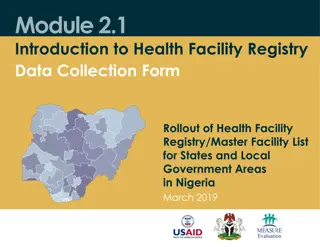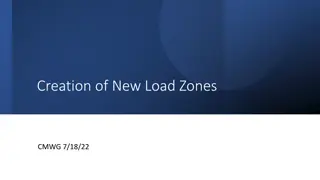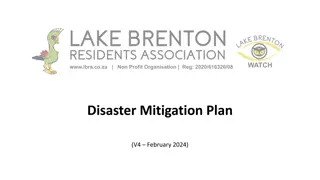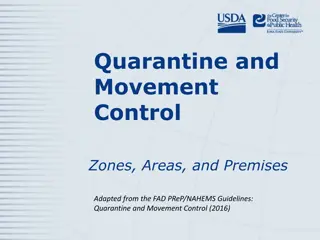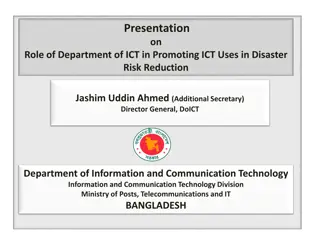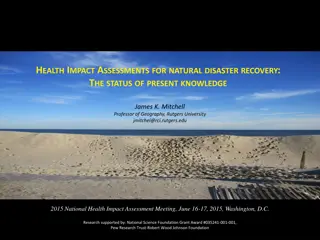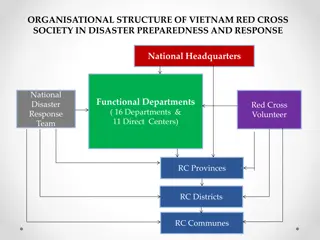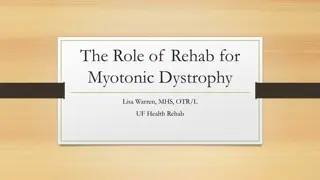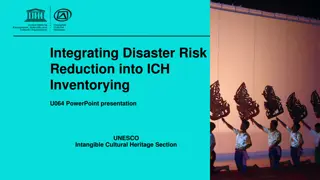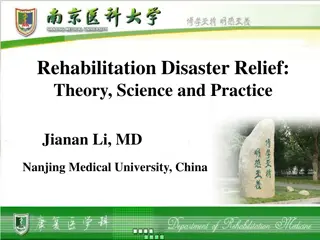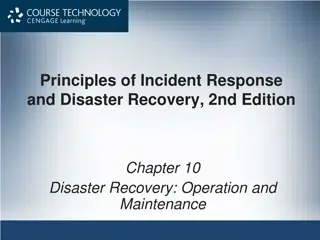Comprehensive Rehab Facility in Disaster Zones
Jianan Li, MD, leading the national disaster rehab team in China, highlights the challenges faced during the aftermath of the 2008 Sichuan Earthquake. Issues such as poor wound management, lack of knowledge in Crush Syndrome, and insufficient resources necessitate the establishment of a comprehensive rehabilitation facility at disaster sites. The call is made for non-government organizations, health departments, hospitals, and volunteers to come together for financial support, medical facilities, and manpower to ensure efficient, effective, and sustainable rehabilitation efforts.
Download Presentation

Please find below an Image/Link to download the presentation.
The content on the website is provided AS IS for your information and personal use only. It may not be sold, licensed, or shared on other websites without obtaining consent from the author.If you encounter any issues during the download, it is possible that the publisher has removed the file from their server.
You are allowed to download the files provided on this website for personal or commercial use, subject to the condition that they are used lawfully. All files are the property of their respective owners.
The content on the website is provided AS IS for your information and personal use only. It may not be sold, licensed, or shared on other websites without obtaining consent from the author.
E N D
Presentation Transcript
Jianan LI, MD Nanjing Medical University National team leader for disaster rehab, China Honorary Chair of ISPRM-CRDR
Date: May 12, 2008 Deaths/missing persons: 86,000 Injured: 374,640; Severely injured: 11,000 Direct economic loss: 100 billion US$
Massive damages Blocked roads Lack of resources Finance Rehab persons Facilities and equipment Lack of coordination Government Hospitals NGOs
Poor wound management Poor operations High incidence of pressure sore Lack of knowledge in Crush Syndrome Lack of systematic early rehab intervention
2008.5.12 Sichuan Earthquake Massive transfer and return
10,000 injured victims return Sichuan Majority of them were dependent: Internal fixation with fracture Imitated mobility Bed rest for SCI and TBI Local rehab strength < 100 rehab physicians < 200 rehab therapists No rehab persons in the community
3 to 5 days training courses were conducted more 40 times No person may practice after training It is not lack of guidelines, but manpower in medical rehabilitation Local medical persons are also victims
What we need: to establish a comprehensive rehab facility on- site of disaster zone: project with high efficiency, efficacy and sustainability. How to organize: N Non-government organizations: to provide financial support H Health department and hospital at disaster zone: to provide basic facilities and some medical support V Volunteers in rehab: to provide manpower.
Chinese Association of Rehabilitation Medicine: Local Health Bureau/ Local Disabled Persons Federation NGOs Health departments Volunteers Capacity building Capacity building Health workforce Financing Governance Rehabilitation Services Rehabilitation Medicine Health: home visits, community adaption Institutional based rehabilitation Community based Livelihood rehabilitation Physical/Occupational therapy Social and empowerment Rehabilitation Psychology
Chinese Association of Rehabilitation Medicine, Local Health Bureau/ Local Disabled Persons Federation NGOs Health departments Volunteers Capacity building Capacity building Health workforce Financing Governance Rehabilitation Services
Rehabilitation Services Rehabilitation Medicine Health Institutional based rehabilitation Community based Livelihood Physical/Occu pational therapy rehabilitation Social and empowerment Rehabilitation Psychology
NHV rehabilitation services programs Handicap International Disabled Person s Federation Health Bureau CBR Local Hospital Earthquake Survivors with SCI IBR Rehab PT/Nurse equipment NGO(CFCF)
Role of physiatrist Organizer, coordinator, diagnosis, clinical management, planning,,,,,,
Outcome: Outcome: 3324 severely injured victims 3324 severely injured victims completed institutional rehab and return to community with high satisfaction. Achievement: Achievement: Department of rehab medicine established in the local hospitals and community based rehab service is gradually spread out. Sustainability: Sustainability: Emphasis is shifting from medical rehab to social rehab.
Method Demography ASIA Quality of Life Complication Pain On-site Survey Ability of Daily Living Walking Ability Depression
Method WHO Quality of Life WHO Quality of Life Assessment Instrument Assessment Instrument- -Bref (WHOQOL (WHOQOL- -BREF) BREF) Demography Bref ASIA The most appropriate scale for QOL of SCI patient Complication Quality of Life Pain Individual s overall perception of QOL & health Domain: Physical Health/ Psychological/Social Relationship/ Environment Ability of Daily Living Walking Ability Depression *Hill MR, Noonan VK, Sakakibara BM, Miller WC. Quality of life instruments and definitions in individualswith spinal cord injury: a systematic review. Spinal Cord. 2009
Method Demography ASIA Complication Quality of Life Pain Pressure Sore/ UTI / Cystolith / Neurogenic Bladder/ Rectum Impairment of Renal Function Ability of Daily Living Walking Ability Depression
Method Demography ASIA Complication Quality of Life Pain Ability of Daily Living Visual Analogue Scale (VAS) Walking Ability Depression
Method Demography ASIA Complication Quality of Life Pain Ability of Daily Living Walking Ability Modified Barthel Index (MBI) Depression
Method Demography ASIA Complication Quality of Life Pain Ability of Daily Living Walking Ability Depression Walking Index for Spinal Cord Injury II
Method Demography ASIA Complication Quality of Life Pain Ability of Daily Living Patient Health Questionnaire Depression Module (PHQ-9) Walking Ability Depression
Result Result Abov e C7 Below S2 AIS C8-T6 T7-L2 L3-S2 Total Percentage A B C D 1 5 2 7 5 19 6 2 7 11 26 23.1% 7.60% 26.9% 42.3% 3 3 1 1 2 2 Total 1
Result Above C7 C7 Above Below Below S2 S2 C8-T6 C8-T6 T7-L2 T7-L2 L3-S2 L3-S2 Total Total Percentage Percentage 3 3 1 1 19 19 1 1 2 2 26 26 100% 100% Pain Pain New pressure sore Neurogenic bladder Cystolith Neurogenic Rectum Heterotopic ossification ossification New pressure sore Neurogenic bladder Cystolith Neurogenic Bowel Heterotopic 1 1 10 10 1 1 12 12 46.2% 46.2% 1 1 12 12 1 1 14 14 53.8% 53.8% 2 2 2 2 7.69% 7.69% 1 1 8 8 2 2 11 11 42.3% 42.3% 1 1 1 1 3.85% 3.85%
Outcome: Outcome: few disabled people (1%). Depression and pain remain the major complains Achievement: Achievement: Local rehab system built up (rehab capacity tripled) and rehab professionals increased 5 times more.
Time: 8 am, April 20, 2013 Immediate reaction post the earthquake: 1 min: internet news 6 min: government announcement 18 min: on-site rescue started 28 min: army team arrived at earthquake zone 120 min: provincial government leaders arrived at the center zone of the earthquake
60 min: 5 national medical teams (180 people) 120 min: National medical consultant organized. 2ndDay: 183 medical teams (1427 people) arrived and medical rehab early intervention started. The ministry of health documents on principle of early rehab intervention and transferring standard. 3rdday: Medical rehabilitation wards established and local rehab resources are sufficient to deal with post earthquake rehab. NHV model implemented in the earthquake zone.
Few disabled persons from disaster Local rehab service built up Community rehab service running well NGO support efficiently
Role of international society? Role of rehab professionals? Volunteer team? Language? Culture and religion? Finance? Diplomatic issue? Safety?
